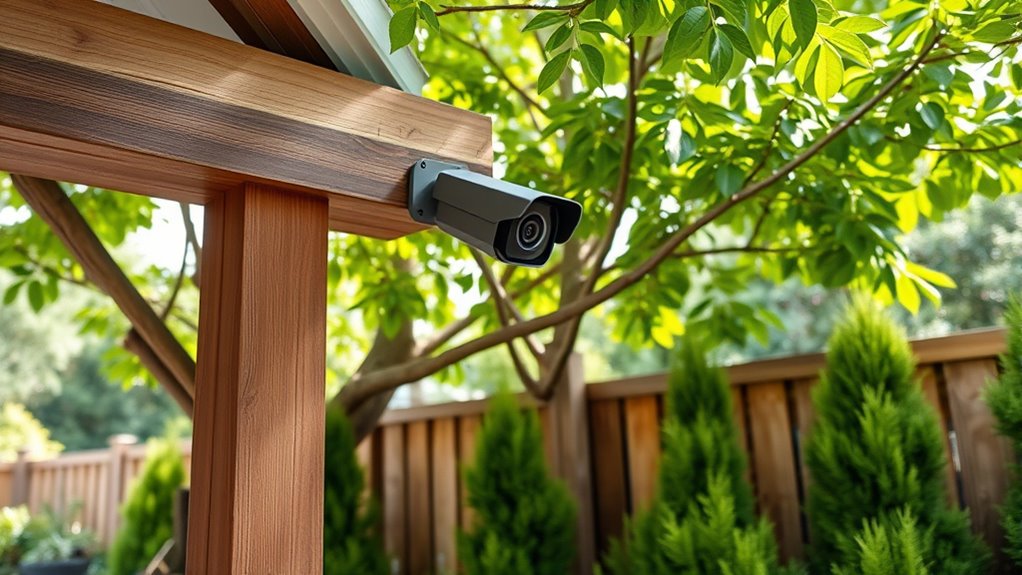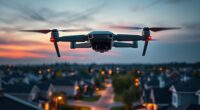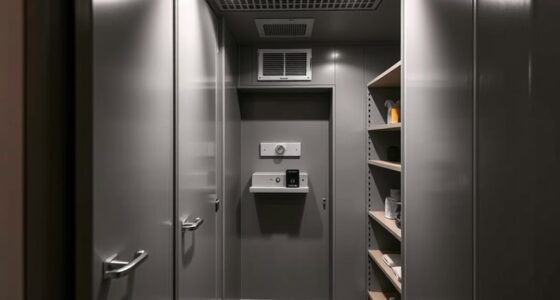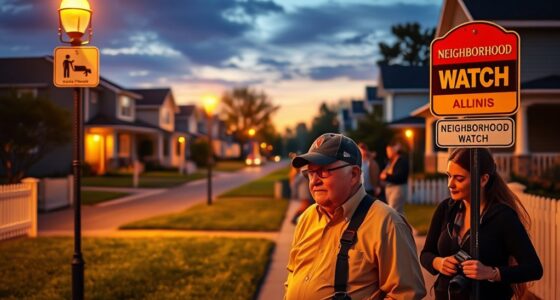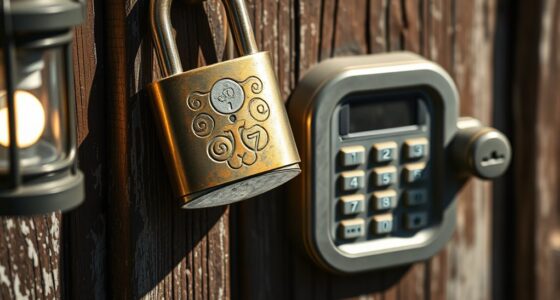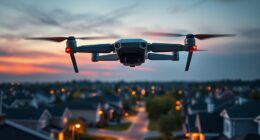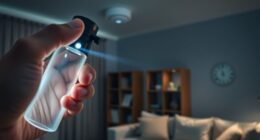To maximize coverage and protect your privacy, position your outdoor camera where it has a clear, unobstructed view of key areas, avoiding shaded spots and glare prone surfaces. Use sturdy mounts high above wildlife activity, and trim surrounding foliage regularly. Aim for even lighting conditions and avoid direct sunlight or reflective surfaces. Prioritizing these placement tips will help you get better footage and safeguard your privacy — learn more to perfect your setup.
Key Takeaways
- Select elevated, unobstructed locations that cover key entry points while avoiding areas with reflective surfaces or glare.
- Position cameras under overhangs or eaves to block harsh sunlight and protect against weather elements.
- Place cameras away from dense foliage or wildlife zones to reduce false alarms and maintain clear views.
- Ensure camera angles balance wide coverage with privacy considerations for neighbors and passersby.
- Regularly trim plants and check for obstructions to maintain optimal visibility and security.

Have you ever wondered where to place your outdoor camera for maximum security? Finding the right spot isn’t just about pointing it at your front door or driveway. You need to consider lighting conditions because they can make or break the quality of your footage. Cameras work best when there’s enough light, especially if you want clear images during nighttime. If you position your camera in a shady area or where the sun causes glare, it might struggle to capture details. Aim for locations with even lighting—ideally where the camera can see well during day and night. Installing a camera under an overhang or eaves can help block harsh sunlight and prevent glare, ensuring clearer images. You should also think about how lighting changes throughout the day and night so your camera isn’t caught in shadows or glaring sunlight that hampers visibility.
Another key factor is wildlife interference. Animals are curious and often unpredictable, so if your camera is placed in a spot where wildlife frequently passes, you might face false alarms or damage. To avoid this, position your camera where it’s less accessible to animals, such as higher up on a sturdy pole or under a protective cover that still allows a clear view. Keep in mind that some animals are active during certain times; for example, raccoons and squirrels tend to be nocturnal, so a camera placed in areas with dense foliage or near trash cans might attract wildlife. This can lead to false triggers on motion detection and clutter your footage with irrelevant activity. To reduce this interference, consider placing your camera away from high-traffic wildlife zones or using models with adjustable sensitivity settings.
Additionally, be mindful of the surrounding environment. Avoid installing cameras where branches, leaves, or other objects can obstruct the view over time. Regularly check that your camera’s line of sight isn’t compromised by growing trees or shrubs. Also, be cautious of reflective surfaces near your camera, which can cause glare or confusing reflections that hinder image clarity. Proper placement takes into account both lighting and wildlife activity, helping you maintain a clear, reliable view of your property without unnecessary disruptions. By thoughtfully selecting your camera’s position—balancing lighting considerations with the likelihood of wildlife interference—you can maximize its effectiveness while preserving your privacy and minimizing false alarms. Remember, a well-placed outdoor camera provides peace of mind, so invest a little time in planning your setup carefully.
Frequently Asked Questions
How Do I Prevent Outdoor Cameras From Being Stolen?
To prevent outdoor cameras from being stolen, you should use camera deterrents like visible signage and bright lighting to discourage theft. Secure your cameras with vandal-proof mounts and hide wiring to make theft more difficult. Regularly check your cameras and consider theft prevention devices like lockboxes. These steps boost theft prevention, making your cameras less tempting targets while maintaining effective security coverage.
What Are the Legal Considerations for Outdoor Camera Placement?
You need to follow privacy laws and respect others’ privacy when placing outdoor cameras. Avoid pointing cameras toward neighboring properties or private areas to prevent privacy violations. Be aware of trespassing concerns, ensuring your camera coverage stays within your property boundaries. Check local regulations, as some areas have specific rules about recording public spaces or private property. Staying compliant helps you avoid legal issues and protects your privacy rights.
How Weatherproof Are Outdoor Security Cameras?
Outdoor security cameras are designed to be weatherproof, with ratings like IP65 or IP66 indicating their durability against rain, dust, and harsh conditions. These weatherproof ratings guarantee your cameras can handle the elements effectively. You can rely on their durability during storms or extreme weather, but it’s wise to choose models with high ratings for maximum protection and longevity. Regular maintenance also helps keep your cameras functioning properly.
Can Outdoor Cameras Record Audio Legally?
Did you know that over 60% of homeowners record audio with outdoor cameras? Legally, you can record audio, but privacy laws vary by location. In many areas, it’s legal if you’re recording in public spaces or with the consent of all parties involved. Always check your local laws before enabling audio recording to avoid privacy violations. Respect privacy laws to make sure your outdoor camera use stays lawful and ethical.
How Do I Choose the Best Camera Angles for Coverage?
To choose the best camera angles for coverage, focus on camera angle selection that covers high-traffic or vulnerable areas like entrances, driveways, or backyard gates. Position cameras slightly above eye level for a wider view and avoid obstructions. Keep privacy in mind by avoiding pointing cameras toward neighbors’ windows. Regularly evaluate and adjust angles to optimize coverage, ensuring you capture essential areas without blind spots or privacy intrusions.
Conclusion
By carefully choosing your outdoor camera spots, you create a vigilant eye over your property, like a silent guardian standing watch at dusk. Imagine the gentle glow of the evening sun casting long shadows while your camera captures every movement, blending security with privacy. With thoughtful placement, you’ll enjoy a clear, unobtrusive view that keeps intruders at bay and your family safe—peace of mind just a glance away, under the open sky.
